Namtso Lake Tibet, often referred to as the Heavenly Lake Tibet, is a breathtaking destination that stands as the highest saltwater lake in the world. Located at an impressive altitude, this sacred lake in Tibet draws visitors for its natural beauty and spiritual significance. Renowned for Namtso Lake trekking and Namtso Lake photography, especially during the captivating Namtso Lake sunrise, the lake offers a pristine environment for those seeking tranquility or adventure. Visitors can engage in Namtso Lake camping and explore the Namtso Lake islands, enhancing their travel experience. With diverse wildlife at Namtso Lake and a variety of Namtso Lake hiking trails, it’s a perfect blend of spiritual journey and natural exploration, making it a pivotal destination for a Namtso Lake tour.
At Druk Holidays, we pride ourselves on being the premier choice for unforgettable journeys to Namtso Lake Tibet. Known for our expertly curated Namtso Lake tours, we ensure that every traveler experiences Heavenly Lake Tibet's profound beauty and spiritual significance. Our tailored itineraries are designed to maximize your engagement with the stunning landscapes and vibrant culture surrounding Namtso Lake, from awe-inspiring Namtso Lake sunrise viewings to immersive Namtso Lake trekking adventures. With Druk Holidays, embark on a journey that explores the scenic majesty of this highest saltwater lake in the world and delves deep into the spiritual essence of one of the most sacred lakes in Tibet.
Heavenly Beauty
The enchanting Namtso Lake, often celebrated as the "Heavenly Lake," offers a sublime panorama that captures the essence of natural splendor in Tibet. Its serene waters, framed by the rugged peaks of the surrounding mountains, create a breathtakingly picturesque setting that draws travelers and pilgrims from across the globe.
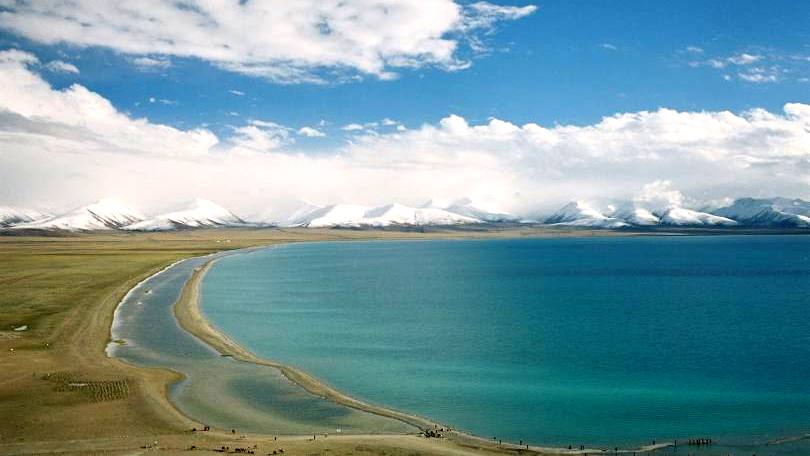
- Pristine Waters: The crystal-clear blue waters of Namtso Lake reflect the vast Tibetan sky, creating a tranquil and almost surreal environment.
- Dramatic Landscapes: Surrounded by the towering Nyenchen Tanglha mountains, the lake provides a dramatic contrast between the calm waters and the rugged terrain.
- Colorful Sunrises and Sunsets: Witnessing a Namtso Lake sunrise or sunset is an unforgettable experience, with the sky and water lit in vibrant hues of orange, red, and pink.
- Star Gazing: Due to its high altitude and clear skies, Namtso Lake is an ideal spot for stargazing, offering views of the Milky Way and countless stars.
- Natural Quietude: The remote location of the lake ensures a peaceful atmosphere, where the only sounds are the natural echoes of the wind and water.
- Mirror-like Reflections: On calm days, the surface of the lake mirrors the sky and mountains, creating perfect symmetrical images that are a photographer’s dream.
- Seasonal Beauty: Each season brings a different aspect of beauty to Namtso, from frozen vistas in winter to blooming wildflowers in spring and summer.
- Floating Ice: In spring, chunks of ice float gracefully across the lake, creating a dynamic and ever-changing landscape.
The Heavenly Beauty of Namtso Lake is more than just a visual feast; it's a profound experience that touches the soul. Each highlight, from the serene reflections to the colorful sky displays, contributes to the lake's reputation as one of the most heavenly places on Earth. Visiting Namtso offers not just a chance to witness these natural wonders but to feel part of something greater—a truly divine landscape.
Spiritual Significance
Namtso Lake, revered as one of Tibet's most sacred lakes, holds immense spiritual significance that resonates deeply within the Tibetan Buddhist community and attracts spiritual seekers worldwide. Known as "The Heavenly Lake," its ethereal beauty and serene atmosphere make it a powerful place for meditation, prayer, and pilgrimage.
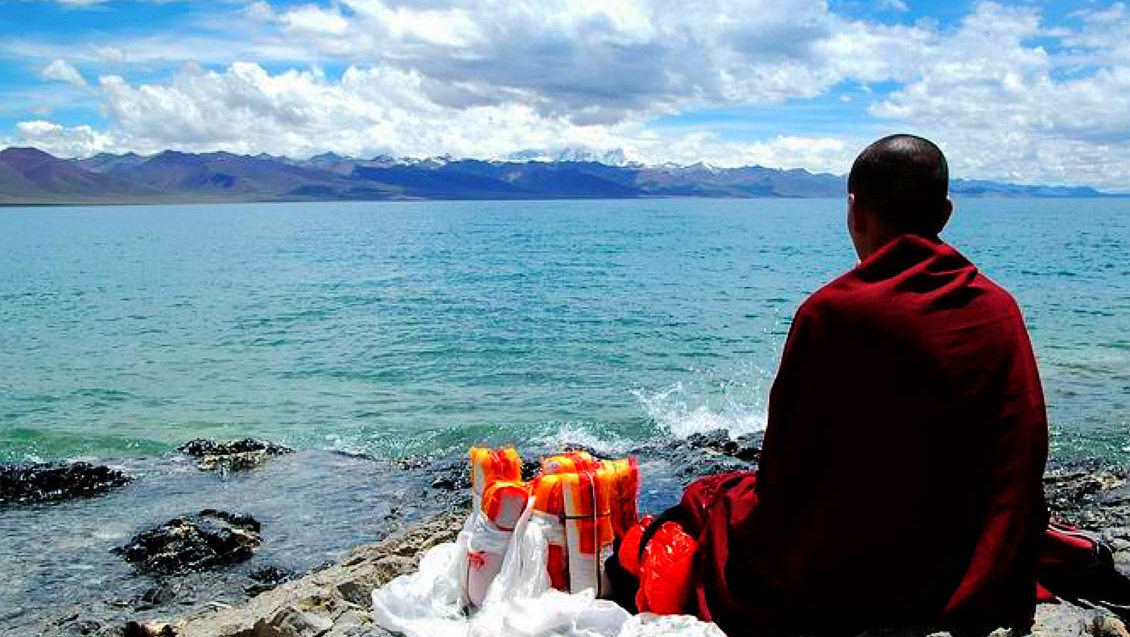
- Pilgrimage Site: Namtso Lake is considered a holy site in Tibetan Buddhism. Many pilgrims undertake the challenging journey to walk around its shores, a practice believed to bring spiritual benefits such as purification and the accumulation of merit.
- Connection with Deities: According to Tibetan belief, Namtso Lake is the abode of Buddhas and deities. It is particularly associated with Chenrezig (Avalokiteshvara), the Bodhisattva of Compassion, enhancing its spiritual allure.
- Spiritual Retreats: The lake's five islands have historically served as secluded retreats for monks and nuns during the summer months when they become accessible. These islands are viewed as ideal places for meditation and isolation, further contributing to the lake’s spiritual importance.
- Religious Festivals: Significant Tibetan festivals involve rituals and prayers that are often conducted at the lake, drawing participants from various regions to celebrate and perform sacred ceremonies together.
- Symbol of Purity: The clear, pristine waters of Namtso Lake symbolize spiritual purity and are often used in rituals and blessings, signifying the cleansing of the soul.
- Healing Powers: Many believe that the lake possesses healing properties, and bathing in its waters or even just touching them can heal sickness and wash away sins.
- Inspiration for Art and Literature: The spiritual essence of Namtso Lake has inspired countless works of Tibetan art and literature, highlighting its importance in the cultural and spiritual life of the region.
- End-of-Life Rituals: It is a place where some Tibetans choose to engage in sky burials and other end-of-life rituals, underscoring its role as a bridge between the earthly and the divine.
The spiritual significance of Namtso Lake is deeply woven into the fabric of Tibetan Buddhism and culture. Its sacred waters and breathtaking surroundings provide a profound space for reflection, renewal, and connection with the divine, making it a pivotal destination for anyone seeking spiritual depth and understanding.
Highest Saltwater Lake
Namtso Lake, renowned as the highest saltwater lake in the world, is a remarkable natural wonder located in the Tibetan plateau. Situated at an elevation of about 4,718 meters (15,479 feet) above sea level, it offers a unique environment and an extraordinary example of high-altitude saline water.
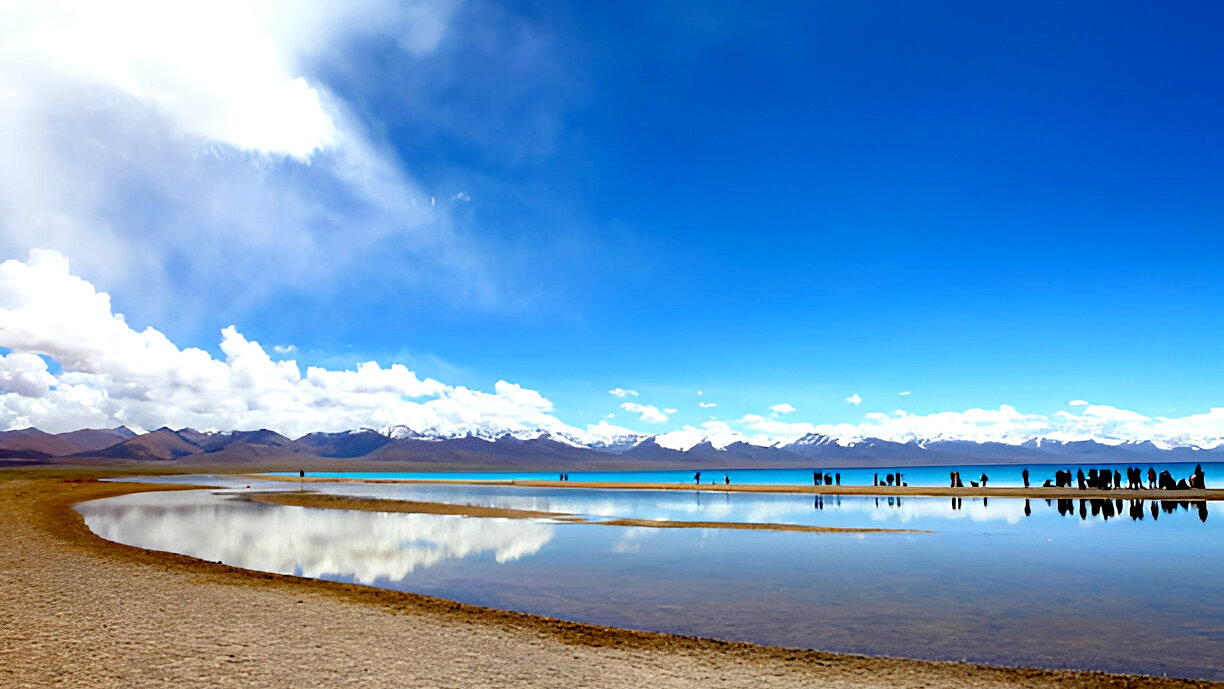
- Extreme Altitude: Being the highest of its kind, Namtso Lake faces extreme environmental conditions, including low oxygen levels and cold temperatures, which influence the types of flora and fauna that can thrive in and around it.
- Saline Waters: The lake is saltwater, a rarity at such altitudes. The salinity arises from the mineral-rich inflows and limited outflows, which concentrate salts in the lake basin.
- Size and Scale: Namtso Lake covers an area of around 1,920 square kilometers (740 square miles), making it one of the largest lakes in the Tibetan Autonomous Region. Its size and the clarity of its waters are visually stunning.
- Isolation and Accessibility: The lake's high altitude and remote location make it less accessible than lower-altitude lakes, contributing to its pristine condition and the preservation of its surrounding ecosystem.
- Climatic Influence: The altitude of Namtso Lake results in a specific microclimate. Weather conditions can change rapidly, and the lake itself is frozen for almost half the year, from October to May.
- Impact on Local Climate: Namtso Lake influences the local climate, moderating temperatures in nearby areas. Its vast surface area impacts wind patterns and humidity levels, creating a unique microenvironment.
- Geological Significance: The lake sits on the Tibetan plateau, which is geologically active. This activity influences the lake’s salinity and water levels, as well as its overall ecosystem.
- Tourism and Preservation Efforts: The unique status of Namtso Lake as the highest saltwater lake attracts tourists and nature enthusiasts from around the world, leading to efforts to preserve its natural beauty and ecological balance.
The title of the highest saltwater lake in the world is not just a geographic notation for Namtso Lake but a testament to its extraordinary natural and spiritual significance. The extreme conditions at such an altitude create a unique ecological niche, making Namtso Lake a fascinating subject for scientific study and a breathtaking destination for visitors seeking both beauty and solitude in the heart of Tibet's rugged landscape.
Stunning Sunrises and Sunsets
The Namtso Lake is not only celebrated for its spiritual significance and breathtaking altitude but also for its mesmerizing sunrises and sunsets. These daily spectacles of light transform the lake into a canvas of vibrant colors, making Namtso Lake a favorite among photographers and nature enthusiasts alike.
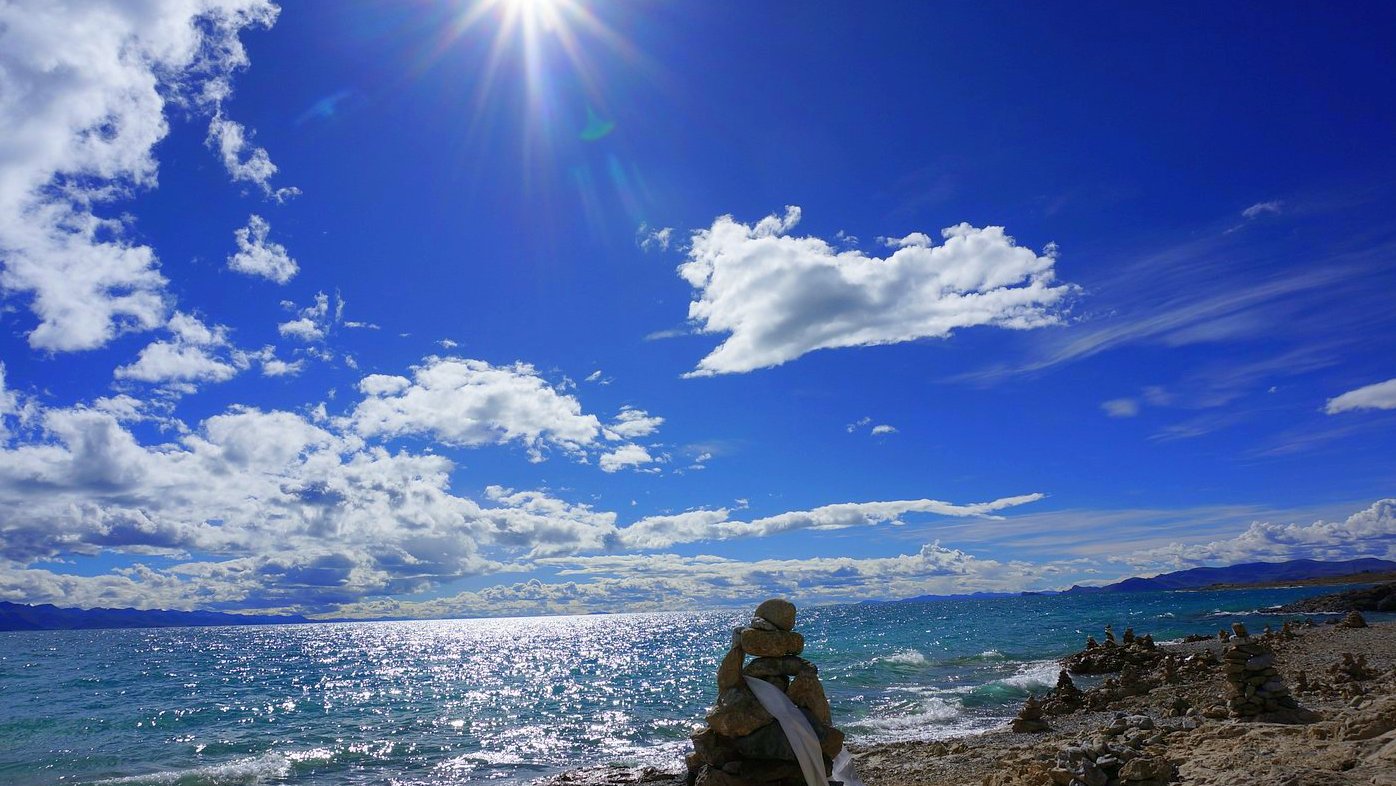
- Vibrant Color Displays: As the sun rises and sets, the clear air and wide horizon at Namtso Lake allow for uninterrupted views of the sky that shift through a palette of deep blues, fiery oranges, and vibrant pinks.
- Reflections on the Water: The calm waters of Namtso Lake mirror the sky, doubling the beauty of each sunrise and sunset. This phenomenon creates perfect symmetrical images, ideal for photography and serene contemplation.
- Ever-changing Scenery: No two sunrises or sunsets at Namtso Lake are exactly alike. The interplay of light and clouds offers a new painting each day, driven by the unique climatic conditions at such a high altitude.
- Enhanced by the Landscape: The surrounding mountains add a dramatic backdrop to the sunrises and sunsets, enhancing the visual spectacle with their silhouettes against the brightly lit sky.
- Spiritual Experience: Many visitors and pilgrims find the sunrise and sunset at Namtso Lake to be not only visually stunning but also spiritually uplifting, adding a profound peace to their experience at this sacred site.
- Prime Time for Meditation: The serene environment during these times makes them ideal for meditation and reflection, often attracting those seeking a moment of tranquility with nature.
- Photographic Opportunity: For photographers, the sunrise and sunset at Namtso Lake provide excellent conditions for capturing stunning landscapes and natural beauty, making it a popular destination for photography tours.
- Accessibility for Viewing: Specific spots around the lake offer optimal viewing experiences for sunrise and sunset, easily accessible by foot or via a short drive from nearby accommodations.
The stunning sunrises and sunsets at Namtso Lake are quintessential experiences for any visitor to this high-altitude wonder. These moments of extraordinary natural beauty not only enhance the visual appeal of the lake but also enrich the spiritual journey of those who witness them, leaving lasting impressions of peace and awe.
Rich Biodiversity
Namtso Lake, renowned for its spiritual and natural splendor, is also a vital ecological habitat that supports a rich biodiversity. Positioned at an extreme altitude in Tibet, the area around the lake boasts unique flora and fauna adapted to its harsh, cold environment.
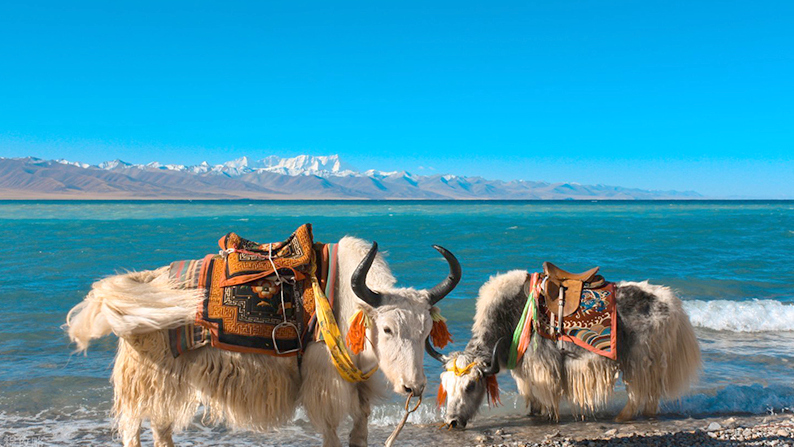
- Adapted Wildlife: The rugged terrain and cold climate around Namtso Lake are home to a variety of wildlife species that have adapted to these conditions. Notable among these are the Tibetan antelope, wild yak, and the rare Tibetan brown bear.
- Birdwatching Haven: Namtso Lake serves as an important stopover for migratory birds. Bird enthusiasts can spot species such as the bar-headed goose and the black-necked crane, which are attracted to the lake’s expansive waters and surrounding wetlands during their migratory seasons.
- Aquatic Life: Despite the saltwater, the lake supports a unique aquatic ecosystem. The lake’s crustaceans and fish species have adapted to the saline environment, contributing to the local food chain and supporting the diverse wildlife.
- High-Altitude Flora: The vegetation around Namtso Lake includes hardy species of grasses and shrubs, as well as vibrant wildflowers that bloom in the brief summer months, adding a splash of color to the landscape and providing sustenance to the local herbivores.
- Ecological Significance: The lake and its surroundings act as a crucial ecological zone, helping to maintain the environmental balance of the Tibetan plateau. The area’s biodiversity is essential for scientific study and environmental monitoring.
- Conservation Efforts: Given its ecological and spiritual importance, conservation efforts are in place to protect Namtso Lake’s biodiversity. These efforts help ensure that the lake remains a sanctuary for its indigenous species and a site for sustainable eco-tourism.
- Impact of Climate Change: The sensitive ecosystem of Namtso Lake is an indicator of broader environmental changes. Scientists monitor the biodiversity here to understand the impacts of climate change on high-altitude habitats.
- Educational Opportunities: For visitors, the rich biodiversity around Namtso Lake not only enhances the experience of natural beauty but also provides educational insights into the adaptations and survival strategies of alpine species.
The rich biodiversity of Namtso Lake underscores its importance beyond just a travel destination. It stands as a living laboratory for ecological and environmental studies and offers visitors a unique opportunity to connect with nature at one of the most biologically diverse and ecologically significant locations on the Tibetan plateau.
Trekking and Hiking
Namtso Lake is not only a spiritual retreat but also a premier destination for trekking and hiking enthusiasts. The challenging terrain and breathtaking vistas offer a unique blend of adventure and tranquility, making it a must-visit for anyone looking to explore the rugged beauty of Tibet on foot.
- Diverse Trails: The area around Namtso Lake offers a range of trails suitable for different skill levels, from leisurely walks along the lake’s perimeter to more strenuous hikes up adjacent mountains for panoramic views of the entire region.
- High-Altitude Challenges: Trekking at Namtso Lake means navigating the thin air at over 4,700 meters above sea level. This high-altitude hiking offers not just stunning scenery but also a test of endurance and acclimatization.
- Pilgrim Paths: Part of the trekking appeal at Namtso Lake includes following in the footsteps of pilgrims. Many visitors undertake the kora, a traditional circuit around the lake, which is believed to bring spiritual benefits and physical well-being.
- Flora and Fauna: As trekkers wind their way through diverse landscapes, they encounter unique high-altitude flora and a chance to spot wildlife, including migratory birds and rare mammals like the Tibetan antelope.
- Guided Treks: For those unfamiliar with the terrain, guided treks are available. These not only ensure safety but also enrich the hiking experience with insights into the local culture, history, and ecology.
- Camping Sites: The adventure doesn’t have to end with sunset. Namtso Lake offers several camping sites where hikers can set up tents and enjoy a night under the stars, fully immersing themselves in the natural surroundings.
- Photographic Opportunities: Every turn and trail around Namtso Lake provides picturesque scenes perfect for photography enthusiasts. The changing light from morning to evening offers varied perspectives of the lake’s majestic beauty.
- Spiritual Connection: Trekking around Namtso Lake also allows for a deeper spiritual connection with the environment. The physical exertion combined with the lake’s serene presence makes for a profoundly meditative experience.
Whether you’re a seasoned hiker looking for your next challenge or a casual walker wanting to soak in natural beauty, trekking and hiking at Namtso Lake cater to all. The combination of physical activity, breathtaking landscapes, and spiritual enrichment ensures that every trekker takes home more than just memories; they experience a transformative journey.
Cultural Insights
Namtso Lake, revered as one of the holiest sites in Tibet, is not only a natural wonder but also a cultural treasure. The lake and its surroundings offer a rich tapestry of cultural insights, reflecting the traditions, beliefs, and lifestyle of the Tibetan people who have lived in harmony with this majestic landscape for centuries.
- Spiritual Practices: Namtso Lake is a significant pilgrimage site for Tibetan Buddhists. Pilgrims from all over Tibet and beyond travel to the lake to perform kora (circumambulation) and other ritual practices, believing these acts bring merit and spiritual purification.
- Nomadic Heritage: The area around Namtso Lake is traditionally inhabited by nomadic herders, who move their livestock between pastures with the changing seasons. Visitors can witness this nomadic lifestyle firsthand, gaining insight into the challenges and beauty of life on the Tibetan plateau.
- Festivals and Celebrations: Several times a year, particularly during special lunar dates, Namtso Lake becomes a hub of activity with festivals and religious celebrations. These gatherings are vibrant displays of Tibetan culture, including music, dance, and traditional storytelling.
- Architectural Elements: While there are few permanent structures around the remote Namtso Lake, the occasional chorten (stupa) and prayer flag installations are poignant reminders of the deep religious devotion in the area. These elements add a spiritual dimension to the landscape and serve as focal points for prayer and meditation.
- Artistic Expressions: The cultural landscape of Namtso Lake is also expressed through art. Thangka paintings, prayer wheels, and intricately carved mani stones (stones engraved with mantras) are commonly found around the area, each telling a story of faith and devotion.
- Interaction with Monks and Nuns: It is not uncommon to encounter monks and nuns at Namtso Lake, many of whom visit for meditation retreats or as part of their spiritual duties. Conversations with these religious practitioners can provide deep insights into Buddhist philosophy and practices.
- Ecological Wisdom: The local communities have a profound understanding of the ecological balance necessary to sustain life in such a harsh climate. Their practices and traditions often include elements of environmental stewardship, which visitors can learn from and apply to their own contexts.
- Culinary Experiences: The diet in the high-altitude regions around Namtso Lake is adapted to the cold climate. Sampling local dishes such as tsampa (barley flour), butter tea, and dried yak meat offers a taste of Tibetan culinary culture and the adaptations necessary for survival in this environment.
Visiting Namtso Lake provides a unique opportunity to delve into the rich cultural fabric of Tibet. Each aspect of life around the lake—from spiritual rituals and nomadic practices to artistic expressions and ecological wisdom—offers a window into the resilience and spiritual depth of the Tibetan people. These cultural insights not only enhance the visitor experience but also foster a deeper appreciation for the complex interplay between nature, culture, and spirituality in this extraordinary region.
Accessible Adventure
Namtso Lake in Tibet offers a stunning combination of natural beauty and spiritual significance, making it an appealing destination for those seeking an accessible adventure. Despite its remote location and high altitude, the lake is increasingly accessible to a broad range of travelers, thanks to improved infrastructure and guided tour services that cater to diverse needs.
- Improved Transportation: Reaching Namtso Lake has become easier over the years with better road conditions and the availability of reliable transportation options from major cities like Lhasa. This accessibility allows more visitors to experience the lake's majestic beauty without the hardships traditionally associated with travel in Tibet.
- Variety of Tour Options: Travel agencies, including Druk Holidays, offer a range of tours to Namtso Lake, designed to accommodate different levels of physical ability and interest. These tours can include comfortable vehicle transport, accommodation arrangements, and even yaks or horses for those who prefer not to walk the entire way.
- Professional Guides: Guided tours provide not only logistical support but also valuable insights into the cultural and natural history of the area. Guides can help manage the challenges of high-altitude travel, ensuring a safer and more enjoyable experience for all visitors.
- Camping Facilities: For those who wish to stay overnight, Namtso Lake offers camping sites that range from basic to more equipped facilities, providing options for different comfort levels. This allows adventurers to immerse themselves in the serene environment of the lake under the stars.
- Health and Safety Measures: High-altitude destinations pose unique health risks, but with increased awareness and preparation, travel to Namtso Lake is more accessible. Visitors are advised on acclimatization processes and have access to medical advice and services to handle altitude sickness.
- Cultural Accessibility: The spiritual and cultural aspects of Namtso Lake are made accessible through interpretive signs, guide narratives, and visitor centers that educate tourists about the lake's significance in Tibetan Buddhism and local traditions.
- Environmental Considerations: Efforts to make travel sustainable also contribute to accessibility. Maintaining the pristine nature of the lake and surrounding areas ensures that it remains a welcoming destination for future visitors.
- Seasonal Accessibility: The best time to visit Namtso Lake is between May and October when the weather is most favorable. During these months, the roads are clear, and the lake's full splendor is accessible to tourists.
Namtso Lake offers an accessible adventure that combines the thrill of remote travel with the comforts of modern tourism. With each visit facilitated by improvements in infrastructure and services, more people can experience the unique blend of natural beauty, spiritual depth, and cultural richness that Namtso Lake has to offer. Whether you are a seasoned adventurer or a casual traveler, Namtso Lake provides a memorable and accessible way to explore one of Tibet’s most iconic landscapes.
Best Time to Visit Namtso Lake
Namtso Lake, known for its breathtaking beauty and spiritual significance, offers different experiences throughout the year. Here’s a seasonal guide to help you decide the best time to visit this majestic lake in Tibet:
Spring (April to June)
- Weather: The weather begins to warm up, but nights can still be quite cold. The ice on the lake starts melting, revealing the stunning blue waters.
- Experience: This is an excellent time for photographers and nature lovers, as the landscape transitions and wildflowers begin to bloom, dotting the terrain with vibrant colors.
- Considerations: The roads are generally clear of snow by late April, making access easier. It's also a quieter season before the influx of summer tourists.
Summer (July to September)
- Weather: Summer offers the warmest weather conditions, with daytime temperatures comfortable for trekking and outdoor activities.
- Experience: Ideal for trekking, camping, and fully engaging with the cultural and spiritual activities around the lake. Pilgrims often visit during this time, providing a rich cultural experience.
- Considerations: This is the peak season for tourism, so expect more visitors and a lively atmosphere. It's also the best time for those interested in deeper explorations of the surrounding areas.
Autumn (October to November)
- Weather: Autumn sees a return of cooler temperatures, but the skies are usually clear and the views are spectacular, with the lake reflecting the crisp autumn skies.
- Experience: The dropping temperatures reduce the number of tourists, making it a peaceful time for those seeking solitude. It’s also an excellent season for photography, with the lake and mountains providing stunning backdrops.
- Considerations: Nights can be very cold, so adequate preparation for low temperatures is essential. The landscape begins to turn golden, offering a different palette of colors.
Winter (December to March)
- Weather: Winter at Namtso Lake is harsh, with heavy snowfall and temperatures that can plummet far below freezing.
- Experience: The lake is often frozen, presenting a unique and serene white landscape. It's a time for quiet and reflection, with fewer tourists and a stark beauty.
- Considerations: Many facilities around the lake may close for the winter, and access can be challenging due to snow-covered roads. It’s essential for visitors in this season to be very well-prepared for extreme cold and potential travel disruptions.
The best time to visit Namtso Lake depends on what you want to experience. For warm weather and vibrant cultural interactions, summer is ideal. If you prefer quieter visits with dramatic autumn colors, then fall is perfect. Spring offers a balance of moderate weather and fewer tourists, while winter provides a tranquil, albeit challenging, beauty. Each season at Namtso Lake has its unique charm and challenges, making it a year-round destination for different reasons.
Things to consider while traveling to the Namtso Lake
When planning a trip to Namtso Lake, there are several important factors to consider to ensure a safe and enjoyable experience. Here are ten key points to keep in mind:
- Altitude Acclimatization: Namtso Lake is located at a high altitude (approximately 4,718 meters). It's crucial to spend a few days acclimatizing in a nearby lower altitude area like Lhasa to avoid altitude sickness.
- Travel Permits: As a foreign traveler in Tibet, you'll need specific permits including a Tibet Travel Permit and an Alien's Travel Permit. Ensure these are arranged well in advance through a travel agency.
- Weather Conditions: The weather at Namtso Lake can be extremely variable and changes rapidly. Prepare for cold and windy conditions, even in summer, and pack accordingly.
- Health Precautions: Carry necessary medications and health supplies, as medical facilities near Namtso are limited. This includes remedies for altitude sickness, colds, and other common ailments.
- Transportation: The roads to Namtso can be rough and are often closed in winter due to snow. Make sure your vehicle is well-equipped for high-altitude travel and consider hiring a local driver familiar with the terrain.
- Sustainable Travel Practices: Respect the natural environment by following Leave No Trace principles. This includes disposing of waste properly and minimizing your impact on the local ecosystem.
- Communication Preparedness: Mobile service can be sporadic around Namtso Lake. Consider bringing a satellite phone if you need consistent communication, or inform someone of your travel itinerary and expected return.
- Camping and Overnight Stays: If planning to camp or stay overnight near the lake, check the availability of campsites and guesthouses. Be prepared with warm camping gear, as temperatures drop significantly at night.
- Local Customs and Culture: Respect local customs and religious practices. This includes dressing modestly, not disturbing prayer flags or other religious artifacts, and seeking permission before taking photographs of local people or religious sites.
- Insurance: Ensure you have appropriate travel insurance that covers high-altitude trekking and medical evacuation, given the remote nature of the destination and the activities involved.
By keeping these considerations in mind, you can better prepare for a memorable and respectful visit to Namtso Lake, one of Tibet's most stunning natural wonders.
Namtso Lake, known as the "Heavenly Lake," is one of Tibet's most awe-inspiring natural wonders and a spiritual haven. As the highest saltwater lake in the world, it offers breathtaking landscapes with crystal-clear waters and majestic mountain backdrops, drawing both pilgrims and adventurers. Whether you're trekking its rugged trails, witnessing its stunning sunrises, or engaging in a spiritual retreat, Namtso promises a transformative experience that connects you deeply with nature and Tibetan culture. This serene destination is not just a place to visit but a profound journey into the heart of one of the most sacred and beautiful landscapes on Earth.
FAQs of Namtso Lake
Q: What is the best time to visit Namtso Lake?
A: The ideal time to visit Namtso Lake is between May and September when the weather is warmer, and the roads are more accessible. This period offers the best conditions for trekking and enjoying the lake's full beauty.
Q: How do I get to Namtso Lake?
A: Namtso Lake is accessible by road from Lhasa, the capital of Tibet. The journey typically takes about 5 hours by car. It is recommended to hire a vehicle with a driver who is familiar with the high-altitude terrain.
Q: Do I need any special permits to visit Namtso Lake?
A: Yes, foreign visitors need a Tibet Travel Permit and an Alien's Travel Permit to visit Namtso Lake. These permits must be arranged through a travel agency before arriving in Tibet.
Q: What should I pack for a trip to Namtso Lake?
A: Due to the high altitude and variable weather, it is essential to pack warm clothing, windproof jackets, sun protection, comfortable hiking shoes, and basic first aid supplies. Also, include high-energy snacks and plenty of water.
Q: Can I camp at Namtso Lake?
A: Yes, there are designated camping areas around Namtso Lake where visitors can set up tents. However, be prepared for cold temperatures, especially at night.
Q: Is it safe to swim in Namtso Lake?
A: Swimming in Namtso Lake is not recommended due to the extremely cold water temperatures and the high altitude, which can make physical activity more challenging and risky.
Q: What wildlife might I see at Namtso Lake?
A: The area around Namtso Lake is home to various wildlife species, including migratory birds, Tibetan antelopes, and yaks. Birdwatchers might catch a glimpse of the rare black-necked crane during migration seasons.
Q: Are there any cultural practices I should be aware of when visiting Namtso Lake?
A: Visitors should respect local customs and religious practices. This includes dressing modestly, not disturbing prayer flags, and seeking permission before taking photographs of local people or religious sites.
Q: How should I prepare for the high altitude at Namtso Lake?
A: To minimize the risk of altitude sickness, acclimatize for a few days in Lhasa or another lower-altitude area before visiting the lake. Stay hydrated, avoid strenuous exercise initially, and consider taking altitude sickness medication if prescribed by your doctor.
Q: Are there any facilities or services at Namtso Lake?
A: Facilities at Namtso Lake are basic. Small guesthouses and shops are selling limited supplies, but it’s best to bring all necessary items with you. Ensure you have enough fuel and a reliable vehicle due to the remote nature of the location.



